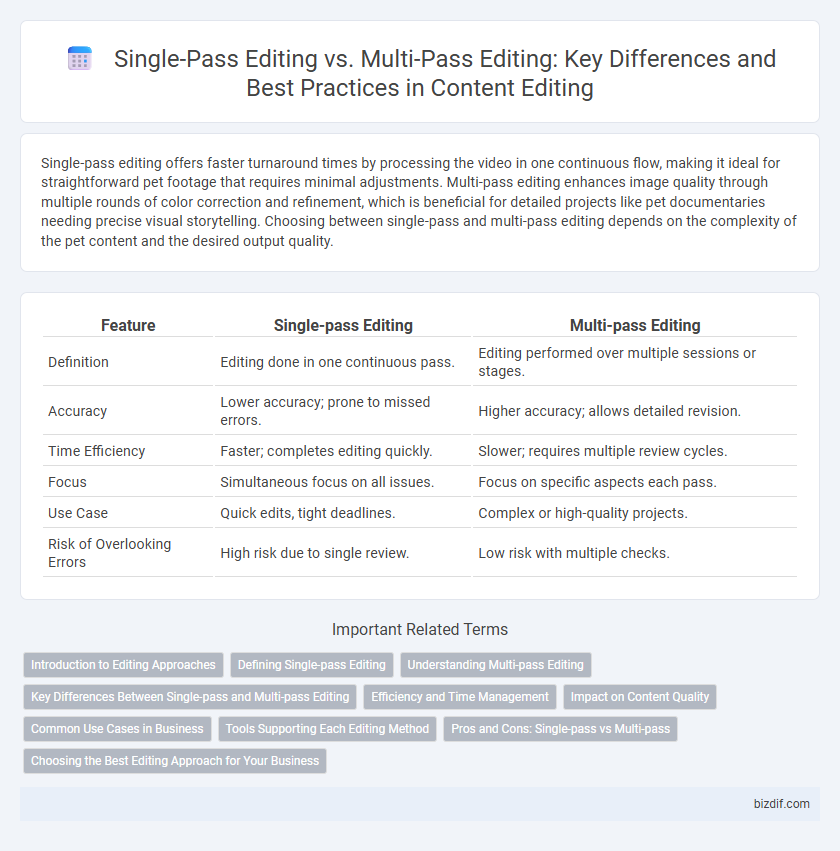Single-pass editing offers faster turnaround times by processing the video in one continuous flow, making it ideal for straightforward pet footage that requires minimal adjustments. Multi-pass editing enhances image quality through multiple rounds of color correction and refinement, which is beneficial for detailed projects like pet documentaries needing precise visual storytelling. Choosing between single-pass and multi-pass editing depends on the complexity of the pet content and the desired output quality.
Table of Comparison
| Feature | Single-pass Editing | Multi-pass Editing |
|---|---|---|
| Definition | Editing done in one continuous pass. | Editing performed over multiple sessions or stages. |
| Accuracy | Lower accuracy; prone to missed errors. | Higher accuracy; allows detailed revision. |
| Time Efficiency | Faster; completes editing quickly. | Slower; requires multiple review cycles. |
| Focus | Simultaneous focus on all issues. | Focus on specific aspects each pass. |
| Use Case | Quick edits, tight deadlines. | Complex or high-quality projects. |
| Risk of Overlooking Errors | High risk due to single review. | Low risk with multiple checks. |
Introduction to Editing Approaches
Single-pass editing involves reviewing and revising a document in one continuous session, allowing for efficient corrections but risking missed errors due to limited focus. Multi-pass editing separates the editing process into distinct stages, such as content review, structural adjustments, and final proofreading, enhancing thoroughness and quality. Choosing the appropriate approach depends on project scope, deadlines, and desired precision.
Defining Single-pass Editing
Single-pass editing refers to the process of reviewing and revising a text in one continuous session, aiming to identify and correct errors, improve clarity, and ensure coherence simultaneously. This approach relies on the editor's ability to efficiently detect different types of issues without the need for multiple reviews. It contrasts with multi-pass editing, where the text undergoes several focused rounds targeting specific elements such as grammar, structure, and style.
Understanding Multi-pass Editing
Multi-pass editing involves reviewing a document multiple times, each pass targeting specific aspects such as structure, clarity, grammar, and style. This method enhances the overall quality by allowing the editor to focus on different elements without being overwhelmed. Effective multi-pass editing results in a polished, coherent, and error-free final draft.
Key Differences Between Single-pass and Multi-pass Editing
Single-pass editing involves reviewing and revising a text in one continuous session, emphasizing speed and efficiency, while multi-pass editing breaks the process into multiple stages focusing on distinct aspects like structure, clarity, and grammar separately. Single-pass editing is ideal for quick projects or drafts requiring immediate completion, whereas multi-pass editing enhances depth and precision, suitable for complex or professional documents. The key differences lie in time investment, detail orientation, and overall quality control, with multi-pass editing offering a more thorough refinement of content.
Efficiency and Time Management
Single-pass editing boosts efficiency by allowing editors to make all necessary corrections in one review, significantly reducing total editing time. Multi-pass editing, while thorough, often requires revisiting the text multiple times, which can prolong project timelines and increase labor costs. Choosing single-pass editing is ideal for time-sensitive projects where maintaining quality with faster turnaround is critical.
Impact on Content Quality
Single-pass editing streamlines the process by addressing surface-level issues such as grammar and punctuation, often enhancing readability but potentially overlooking deeper structural or thematic inconsistencies. Multi-pass editing involves multiple stages, allowing for comprehensive refinement of content quality through iterative review of clarity, coherence, and narrative flow. This method typically results in higher quality content by systematically addressing both technical and substantive aspects of the text.
Common Use Cases in Business
Single-pass editing is ideal for quick revisions and content updates in fast-paced business environments where time efficiency is crucial. Multi-pass editing offers thorough refinement suited for important documents such as marketing materials, reports, and proposals requiring accuracy and polished language. Businesses leverage single-pass editing for routine communications, while multi-pass editing ensures high-quality output in client-facing deliverables.
Tools Supporting Each Editing Method
Single-pass editing tools streamline real-time corrections with integrated spell checkers and grammar analyzers, enhancing efficiency in dynamic environments. Multi-pass editing software offers layered functionalities such as stylistic suggestions, consistency checks, and structural analysis, supporting in-depth revisions through sequential review cycles. Advanced platforms like Adobe InCopy and Grammarly cater to both methods with customizable workflows, enabling editors to switch between rapid edits and comprehensive refinement.
Pros and Cons: Single-pass vs Multi-pass
Single-pass editing offers speed and efficiency by allowing quick revisions in one go, making it ideal for simpler projects or tight deadlines; however, it can increase the risk of overlooking errors or inconsistencies. Multi-pass editing provides a more thorough approach by separating tasks such as structural changes, copyediting, and proofreading into distinct rounds, improving accuracy and overall quality but requiring more time and effort. Choosing between single-pass and multi-pass editing depends on project complexity, quality requirements, and available resources.
Choosing the Best Editing Approach for Your Business
Single-pass editing streamlines content review by addressing issues in one focused sweep, ideal for quick turnarounds and straightforward projects. Multi-pass editing involves multiple detailed reviews targeting different elements such as grammar, style, and factual accuracy, making it suitable for complex or high-stakes content. Businesses should assess their project scope, deadlines, and quality standards to select the most effective editing approach, balancing efficiency with thoroughness.
Single-pass editing vs Multi-pass editing Infographic

 bizdif.com
bizdif.com